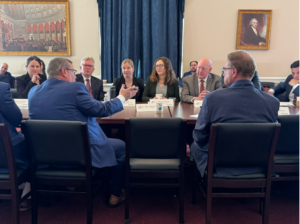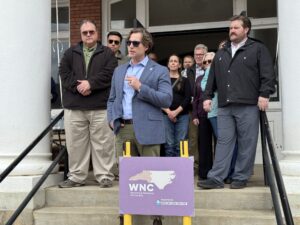May 14, 2021
 AFC’s Florida Director Alec Bogdanoff attends the signing (Photo Credit: Randy Deshazo)
AFC’s Florida Director Alec Bogdanoff attends the signing (Photo Credit: Randy Deshazo)
Despite pandemic-related challenges throughout this spring’s state legislative session, Florida took huge legislative and budgetary steps to address flooding and sea level rise. On Wednesday, May 12, Governor Ron DeSantis signed into law the landmark ‘Always Ready’ legislation, outlined below. AFC was honored to provide policy recommendations during the development of the legislation.
In early May, the Legislature also passed a budget with over $650 million dedicated to resilience planning and infrastructure for the coming fiscal year. This budget, which was signed June 2, includes $500 million of stimulus funds for resilient infrastructure, which is much higher than in previous years.
Below are some more details of the monumental ‘Always Ready’ or SB1954 legislation and how you can prepare for the new funding:
What does the ‘Always Ready’ legislation do?
- Prioritizes resilience infrastructure projects through a statewide plan. The Florida DEP will develop a plan to understand statewide flood vulnerability while systematically prioritizing and funding projects on a multi-year cycle (similar to FDOT’s transportation work plan).
- Local projects included in the statewide plan will be funded up to 50% of project costs (or more for financially disadvantaged small communities).
- Puts $100+ million annually toward resilience projects. With this funding, the state will now welcome local governments, drainage districts, and water management districts to submit flood protection projects for consideration. (In addition to the proposed annual $100 million in state funding this year, it looks like $500 million of federal stimulus dollars will also be available).
- With sustained annual funding and a more systematic process for prioritizing projects, this substantially changes how resilience projects are funded.
- Supports smaller and rural communities. For financially disadvantaged small communities, the state will cover a greater percentage of project costs.
- Regional resilience entities are able to provide technical assistance, and projects that assist these communities will receive additional points in the state’s ranking system.
- Creates the Resilient Florida Grant Program. Building on the existing Florida Resilient Coastlines Program, the new legislation allows local governments to access state support for resilience planning efforts, such as vulnerability assessments.
- Other notable elements:
- Develops new guidance for flooding and sea level rise vulnerability assessments, which will provide clarity on sea level rise projections and planning horizons for local communities.
- Creates a Florida Flood Hub for Applied Research and Innovation, based at the University of South Florida, to drive innovation and serve as a central repository for statewide flood data.
- Requires the Office of Economic and Demographic Research to develop an estimate of future expenditures needed to minimize the harm of flooding. This estimate will inform future flood resilience investments in both inland and coastal communities.
How should you prepare?
- Evaluate if your community has completed flooding and sea level rise planning exercises, such as flood or sea level rise vulnerability assessments, stormwater master plans, or hazard mitigation plans.
- If your community recently completed or is in the process of completing a vulnerability assessment, review the legislation to ensure the assessment follows the new state guidance.
- Determine the shovel-worthy flood protection projects that might be eligible for state funds and how to meet the cost share requirement.
- Consider a range of funding sources to make projects a reality. Local and state dollars can often be combined with federal funds to satisfy the local match for grant requirements.
Over the coming months, we will monitor the implementation of the new law and will keep you informed on how to access funds as information becomes available.
AFC was proud to work with state leaders on this legislation, which marks a significant change in how Florida plans for and addresses the impacts of higher seas, stronger storms, and more frequent flooding. Thank you to our local members who are the foundation of our successes and what we do.
Additional resources to learn more:
- Our webinar discusses how the new legislation establishes a framework and funding to build statewide resilience and what communities should do now to prepare for the approaching application cycle.
- Our guidance on performing a vulnerability assessment provides tips if you have not already performed one
- Our new Adaptation for All guide provides great ideas on flood resilience projects for communities of all sizes
- Our Flood Funding Finder can help you find federal funding opportunities for your community






